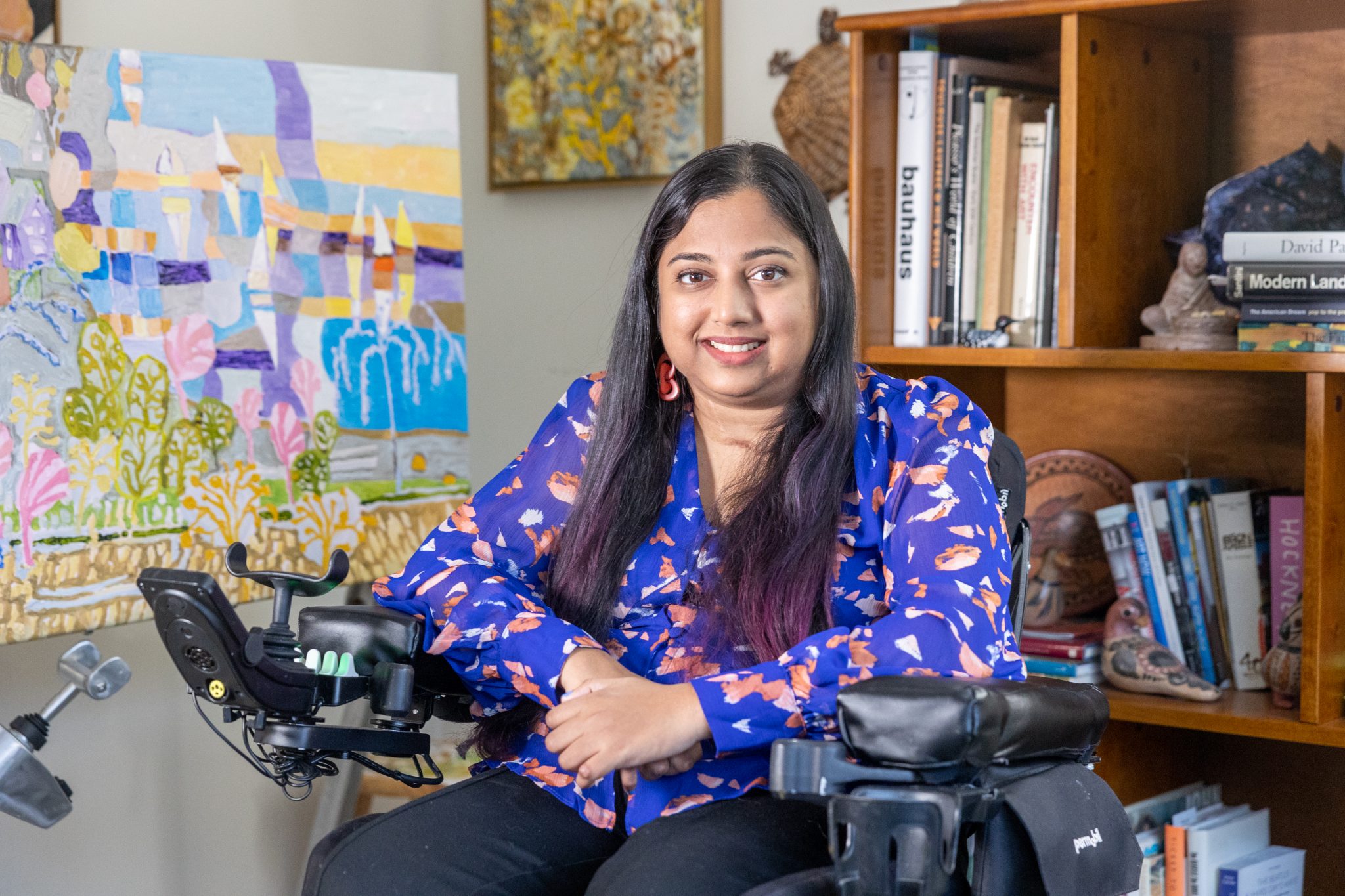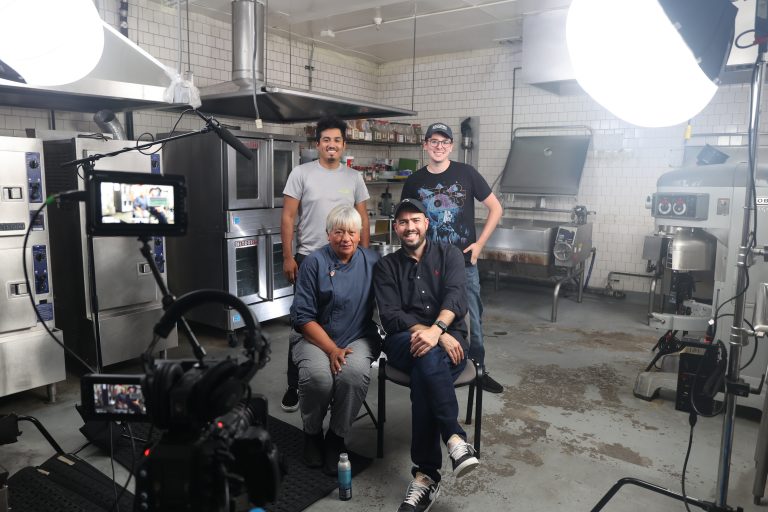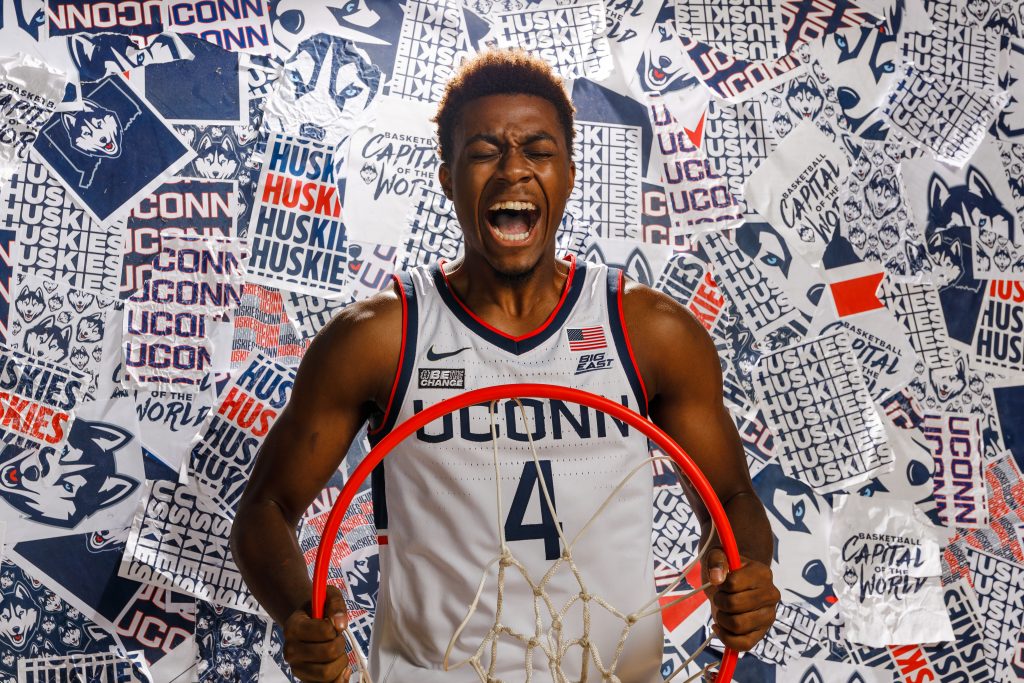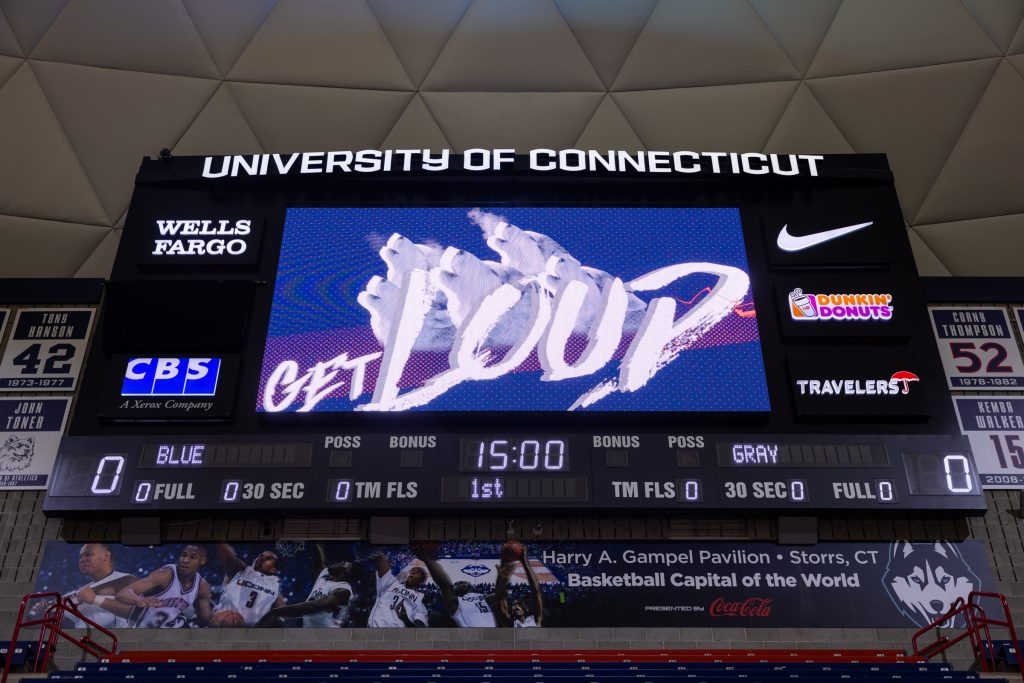|
UConn’s first integrative studies student bridges passion for art, engineering in research and life

Arpita Kurdekar’s story doesn’t start at the point she came to the United States, or when she got her dream job as an engineer, or when she pivoted to graduate studies at UConn. It doesn’t even begin when, as a young woman just starting out, a tree limb fell on her, rendering Kurdekar paralyzed from the chest down.
Her story begins long before all of that, when she was a young girl in India, and first picked up a paintbrush. It was a childhood hobby stoked by two artist parents and encouraged by accolades and a few awards for her work.
Growing up, Kurdekar was caught between an affinity for art and a passion for math and science, the latter winning out educationally and professionally when she pushed painting aside and sought to design bridges as masterful as her favorite, the Brooklyn Bridge.
Never did she think the bridge that would become her greatest accomplishment to date would be the one that marries engineering and art, bringing travelers to a place that merges the two – if only virtually.
‘My life changed in just a moment’
Kurdekar earned a master’s degree in engineering from the University at Buffalo in 2015 after completing her undergraduate degree in India and working a few years at a structural engineering firm there. She came to the U.S. for the opportunity of advanced education and the hope for a professional license not long thereafter.
While at Buffalo, an internship at the New Hampshire Department of Transportation provided a conduit to a full-time position in the Granite State at GM2 Associates, where she focused on structural design calculations for projects in Connecticut, New Hampshire, and Vermont.
She says she enjoyed the work, suiting up in a safety vest and headlamp out in the field, ascending into the underbelly of structures for visual inspections, and sometimes walking through construction sites as workers laid the steel girders that help give a bridge its strength.
“One day, about seven months after I started at GM2, I went home after work and planned to go to the gym. As I walked down the driveway, a neighbor’s tree fell on me and immediately I was paralyzed with a spinal cord injury,” she says. “My life changed in just a moment.”
Kurdekar says she lay on the ground calling for help for an hour because she was in a location that neighbors couldn’t readily see. Eventually her roommate came home, and Kurdekar says she remembers being found. She then lost consciousness.
Girish and Vandana Kurdekar traveled from India as quickly as possible to sit by their daughter’s bedside, and today provide her around-the-clock care. Her first memory after the accident was waking to them in the hospital.
“It was a very difficult time,” Kurdekar says of those early days of recovery. “I was on a ventilator, so it has been a long recovery journey. I had to learn to breathe on my own again, how to talk, how to eat, and how to move what parts of my body I could. It has been a very, very long and difficult six years.”
Those early days of rehab at Spaulding Rehabilitation Hospital Boston were centered on regaining the most basic of life skills. Once Kurdekar moved to Crotched Mountain Rehabilitation Center in Greenfield, New Hampshire, a therapist suggested she tap not just into the muscle memory of the art from her youth but also the peace it gave her.
At first, Kurdekar says the only movement she had was shrugging her shoulders. Then, with the aid of a splint, she learned to hold a paintbrush. Eventually, she wrote her name, and later she painted flowers.
“I remember those sunflowers,” she says with a giggle. “They didn’t look like sunflowers – only my therapist and I knew they were sunflowers. Still, art has been an outlet of joy for me to fight depression and feel happy again. It gives me a lot of rest and peace.”
As she awakened to the value of art in her life, Kurdekar returned to work at GM2 for a few months before assessing her professional future and recognizing academia was the place she wanted to be.
GM2 President and CEO Manish K. Gupta ’98 MS, ’01 Ph.D. had become a mentor to Kurdekar and spoke fondly of his time at UConn. At his urging, she applied.

Teaching with VR Technology
Accepted into the School of Engineering Ph.D. program in 2018 and poised to study civil engineering, Kurdekar realized the passion she’d had for engineering had waned, though it wasn’t extinguished. She thought there might be a way to bring art and engineering together to complement each other.
Kurdekar says she shared with faculty in the schools of Education, Engineering, and Fine Arts her idea to create virtual reality technology to help students learn engineering principles that can be difficult to understand via a two-dimensional description in a textbook or on a screen – think thermodynamics, angular momentum, and gyroscopes.
It’s technology that visual artists, too, could use to practice their skills or plan for a piece that might be too large or cost prohibitive to build as a prototype.
“I’m aiming to teach concepts related to rigid body dynamics and specific art movements and art-making techniques through the overarching theme of kinetic sculptures,” she says. “I wish to present the learning experience in a more interesting and playful manner, in which the students can engage in creative thinking and problem solving by applying learning from both fields. That’s the kind of education we need to give students to prepare them to become innovative thinkers.”
She assembled a team of advisors from each of the three schools and became UConn’s first Integrative Studies Ph.D. candidate. It’s a program that allows students to combine several disciplines into one study track that doesn’t fit neatly into an existing department. Kurdekar hopes to finish her degree in 2024.
She has a fellowship from the Krenicki Arts and Engineering Institute, for which she’s been a teaching assistant in courses such as Entrepreneurship & Innovation in Industrial Design, Packaging Design, and Human Factors in Design. Kurdekar also has received support from the Dr. Radenka Maric Fellowship Fund for Engineering.
“There are a lot of parallels between my research and the art-making process,” she says. “In both, I focus my energy on solving creative challenges, whether on canvas or in a 3D virtual space. I want the viewer to be moved by the visuals and feel the same sense of engagement and enjoyment as I had during the making of it.”
In the beginning, though, Kurdekar was not a computer programmer. She says she’d picked up only bits of coding experience during school and needed to lay that foundation before building up.
Advisor Kenneth Thompson, an assistant professor in-residence in UConn’s Digital Media & Design department, taught Kurdekar’s first class, Introduction to Game Scripting.
“It takes grit to go from nothing to where Arpita is now,” Thompson says. “Since she came at it with a background in engineering, she already had the foundational logic and thought process that allowed her to excel in class. She knew where she wanted to go, and that made it easy to point her toward the material she needed to learn.”
Kurdekar found supplemental instruction on YouTube, and, coupled with DMD classes, gained proficiency in the language C#, or C Sharp.
Making Her Mark in a Burgeoning Field
“Game development is a ubiquitous thing that we see everywhere,” Thompson says. “Your mailer that you get from the grocery store asks you to go on a quest for a 75-cent-per-pound ham to get experience points on your badge when you scan your card. Gaming is applied in different ways. Arpita really made the case that what she’s doing with VR is valuable from an educational research perspective and adds to the numerous projects being done across campus and disciplines.”
Thompson says that while people might associate VR mostly with gaming or entertainment, the technology merely helps users understand something at scale: “It’s like the first time you step out of a car or an airport in a big city and you have that feeling of looking up. It’s kind of overwhelming to feel that sense of height. VR provides that kind of experience and makes it possible to communicate or teach it.”
He says that a giant swinging pendulum, for instance, might be too dangerous, too difficult, or too expensive to create or too limited to have more than one per class. Kurdekar’s VR technology will allow students to learn concepts related to that pendulum because it will be right in front of each of them.
“People who are working on VR technology now, like Arpita, they’re the ones who are going to make marks and be the forebearers of how we have new experiences and interact with things,” he says.
School of Engineering Associate Dean Daniel Burkey, another of Kurdekar’s advisors, says some UConn faculty members already have begun to use VR technology for straightforward purposes, like looking at landscapes, viewing topographical maps, or manipulating objects.
Kurdekar’s work differs in that it’s more immersive.
Burkey says what’s being used now is in addition to classroom lessons, whereas Kurdekar’s technology will bring the educational space into the virtual world.
“That’s the defining feature and that’s something that will be really impactful moving forward,” he says. “The other interesting thing about Arpita’s work is that it is applicable to a lot of different engineering fields. Engineering has a strong psychometric component; it’s very hands on. Sometimes it’s difficult to give students an authentic hands-on experience. Virtual reality allows you to do that in a much more authentic way than simply interacting with something on a screen, or reading a case study, or doing it in pen and paper.”
Thompson adds that the pandemic accelerated the mainstream’s adoption of VR technology, especially since the cost of the requisite hardware is decreasing.
Burkey says, “Previous generations of the hardware have been large. They’ve been bulky. They’ve been attached to a computer with a lot of wires. There’s lag time that can be disorienting for people. The increases in computing power, the shrinking of technology, the reductions in cost are all making it a lot more accessible.”
Accessibility for those with limited mobility also has been central to Kurdekar’s research, especially since she’s just beginning to move her fingers at the first knuckle thanks to surgeries in 2021 and 2022.
“For five years I couldn’t move a finger, and now I can,” she says. “This is very new research, and Dr. Justin Brown, my doctor, at the Paralysis Center at Spaulding, is one of only a few doing it. Who knew this could happen for me, but it did. People are doing research and breakthroughs are happening every day. These unbelievable changes in my life have made me look at the future in a very positive way.”
Immersed in Art, Memorizing Nature
At home, Kurdekar paints as often as possible, trying to fill most of her free time with it and having done hundreds of pieces, many of which she has posted on Instagram and her website. Lately, she’s tried painting on wood and even using clay to create pottery.
“

I started off with representational style paintings, trying to make things look real, very life-like,” she explains. “But slowly, I realized my inner voice was missing in the art I was creating. So, I started laying fragments of my memories and experiences with people, places, and things on my canvases. My work started becoming more abstract and meaningful as I traced those memories with the use of expressive brushstrokes and vibrant colors.”
Using the beauty of New England as a muse, she adds, “It’s hard not to have imprints of the sunsets, the sky mixing with the water, or even the energetic shifting movements of the birds foraging the farms and the feeders in your mind and heart.”
In 2019, Kurdekar’s work went on display for the first time at the Mansfield Community Center. Since then, she’s exhibited there and at various galleries, including Arts Center East in Vernon, and has won a few awards in area juried art shows.
She continues to find inspiration in nature. Last summer, she and her parents visited Maine and ascended Cadillac Mountain in Acadia National Park via wheelchair ramps that stretched to the top. She saw views of the ocean and islands below, memorizing the shapes and colors of the scenery.

“I was a totally different person before the accident,” she says. “I was active. I would dance, I would hike, I would drive to different places. I lost a lot. But this journey has made me a different person. It’s opened my eyes to see what’s important in life. I realized who my true friends are and what really matters. I would never have gone on for my Ph.D. and do the research I’m doing if this hadn’t happened. It gave me a new direction and I totally enjoy what I do now.”
The biggest obstacle at this juncture is her and parents’ immigration status. None of them have U.S. citizenship, keeping Kurdekar from obtaining certain home-care services and her parents’ the ability to apply for driver’s licenses, work here, and get medical insurance.
U.S. Rep. Ann M. Kuster, D-N.H., introduced legislation in 2021 to relieve some of that strain and grant the family of three lawful permanent resident status. That bill, HR680, passed the House in June, the Senate on Dec. 21, and received President Joe Biden’s signature on Jan. 5.
“My parents had tourist visas and every six months they had to renew them in order to stay here legally to care for me. There was always uncertainty they wouldn’t get approved and that was a very big worry for me,” Kurdekar, who now will have a green card, says.
Going back to India isn’t an option. The infrastructure is not handicapped friendly, which means she wouldn’t have job opportunities let alone be able to obtain medical care that, she says, would be inferior to what she’s receiving here.
“I don’t know if I’d even be able to survive there,” Kurdekar says. “All the skills, all the hard-earned skills I have wouldn’t be utilized. In the U.S., every individual has equal opportunities in spite of their physical abilities. I can do a lot here. I can use my knowledge and skills to contribute to society.”
Despite all of this, she’s carried on.

An engineer friend designed and built an adaptable easel that, with the push of a joystick, can rotate a canvas, lift it, push it left or right, or tilt it to give Kurdekar easier reach. The palate of paint rests on the tray of her motorized wheelchair as she gets lost in the small brushstrokes that give her paintings their texture and movement.
“Life is much better than what it was five years back,” she says. “I want to tell people who are struggling not to be afraid. Take one day at a time. Have small goals and try to achieve them. If you really work hard, there’s always a way out. You can always find a way. If you keep looking, you’ll eventually find an answer.”
UConn Today Article: https://today.uconn.edu/2023/01/laying-a-new-foundation-before-building-up-uconns-first-integrative-studies-student-bridges-passion-for-art-engineering-in-research-and-life/
 Guerra, with Connecticut Congressman Jim Himes, and the production team for Grit & Grace (Contributed Photo)
Guerra, with Connecticut Congressman Jim Himes, and the production team for Grit & Grace (Contributed Photo)







